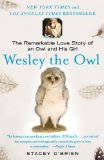Summary | Excerpt | Reading Guide | Reviews | Beyond the Book | Readalikes | Genres & Themes | Author Bio

The Remarkable Love Story of an Owl and His Girl
by Stacey O'Brien1
The Way of the Owl
On a rainy Valentine's Day morning in 1985, I fell in love with a four-day-old barn owl. I'd been working at Caltech (California Institute of Technology) for about a year when one of the scientists called me into his office. He mentioned that there was an owl with an injured wing, and said, "Stacey, he needs a permanent home."
The little owl was so tiny and helpless he couldn't even lift his head or keep himself warm. His eyes weren't open yet, and except for a tuft of white down feathers on his head and three rows of fluff along his back, his body was pink and naked. I was smitten beyond reason by his hopelessly goofy appearance. He was the most wonderful creature I'd ever seen, gorgeous in his helplessness. And, oh, was he uncoordinated. His long, lanky legs stuck out awkwardly, and his oversized talons erratically scratched anyone who held him. His scrawny body had two little nubs that would eventually become wings, and his ungainly pterodactyl-like head wobbled from side to side. It seemed as if he had been assembled from the flotsam and jetsam of many different creatures.
Under normal circumstances, a rehabilitation center would have raised him using owl puppets to feed him and teach him to live in the wild, which is how biologists have raised endangered birds like sandhill cranes and the California condor that they intend to release. But this baby had nerve damage in one wing, so although he might one day be able to fly well enough to hunt sporadically, his wing could never build up to the level of endurance he would need to survive in the wild.
Like all barn owls, the baby smelled like maple syrup but not as sweet, something closer to butterscotch and comfy pillow all in one. Many biologists at Caltech, where I both worked and took classes, would bury their faces in their owls' necks to breathe in their delicate, sweet scent. It was intoxicating.
Scientists from all over the world were on our barn owl research team. There are seventeen species in the barn owl family and they live on every continent except Antarctica, but the ones we worked with were all Tyto alba, the only species that lives in North America. Found from British Columbia across North America through the northeastern and southern United States, as well as in parts of South America and the Old World, barn owls are raven-sized birds, about 18 inches from head to tail. They weigh only about one pound full grown, but their wingspan is magnificent -- averaging three feet, eight inches -- almost four feet across. And barn owls are strikingly beautiful; their feathers are largely golden and white and their faces a startling white heart shape.
As gorgeous as they are, it is the owls' personalities that invariably capture the hearts of the people who work with them. All of the Caltech scientists grew intimately attached to their birds. One big, strapping scientist worked with an owl that got loose, flew into the ventilation system of the building, and there somehow hurt his foot. Owls are very sensitive and easily stressed. Even though the injury was minor and the owl was taken care of right away and not in any pain, he just turned his head to the side and wouldn't look at anyone or eat. Within a day, the owl died. The incident had so upset him that he turned his head away from life, and there was nothing any of us could do to coax him back. After he died, the big tough scientist sobbed and cradled the owl's body in his arms. Then he took a short leave of absence. That's how much the owls would work their way into our hearts.
This tragic behavior wasn't unusual for owls, who are emotionally delicate, even in the wild. For example, owls mate for life, and when an owl's mate dies, he doesn't necessarily go out and find another partner. Instead, he might turn his head to face the tree on which he's sitting and stare fixedly in a deep depression until he dies. Such profound grief is indicative of how passionately owls can feel and how devoted they are to their mates.
Copyright © 2008 by Stacey O'Brien
Your guide toexceptional books
BookBrowse seeks out and recommends the best in contemporary fiction and nonfiction—books that not only engage and entertain but also deepen our understanding of ourselves and the world around us.